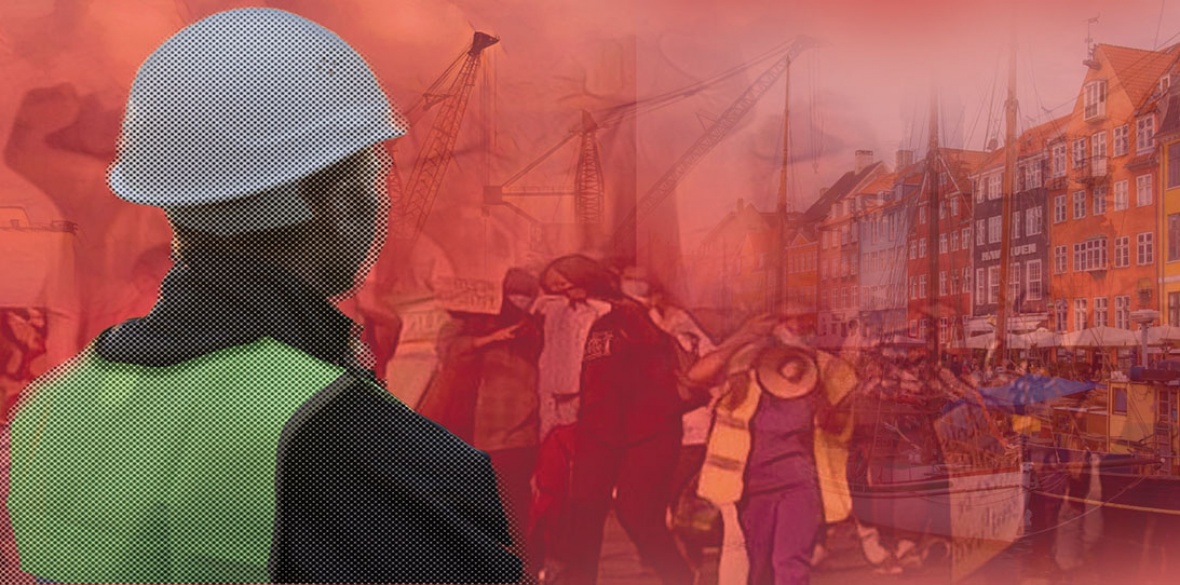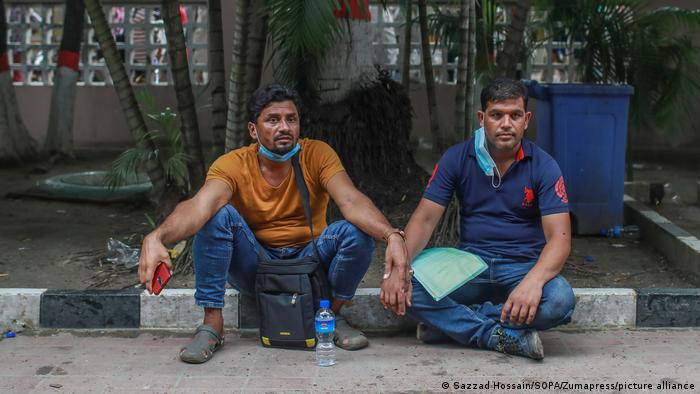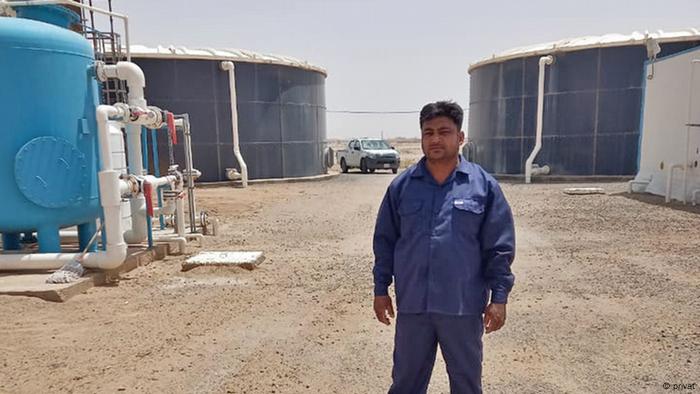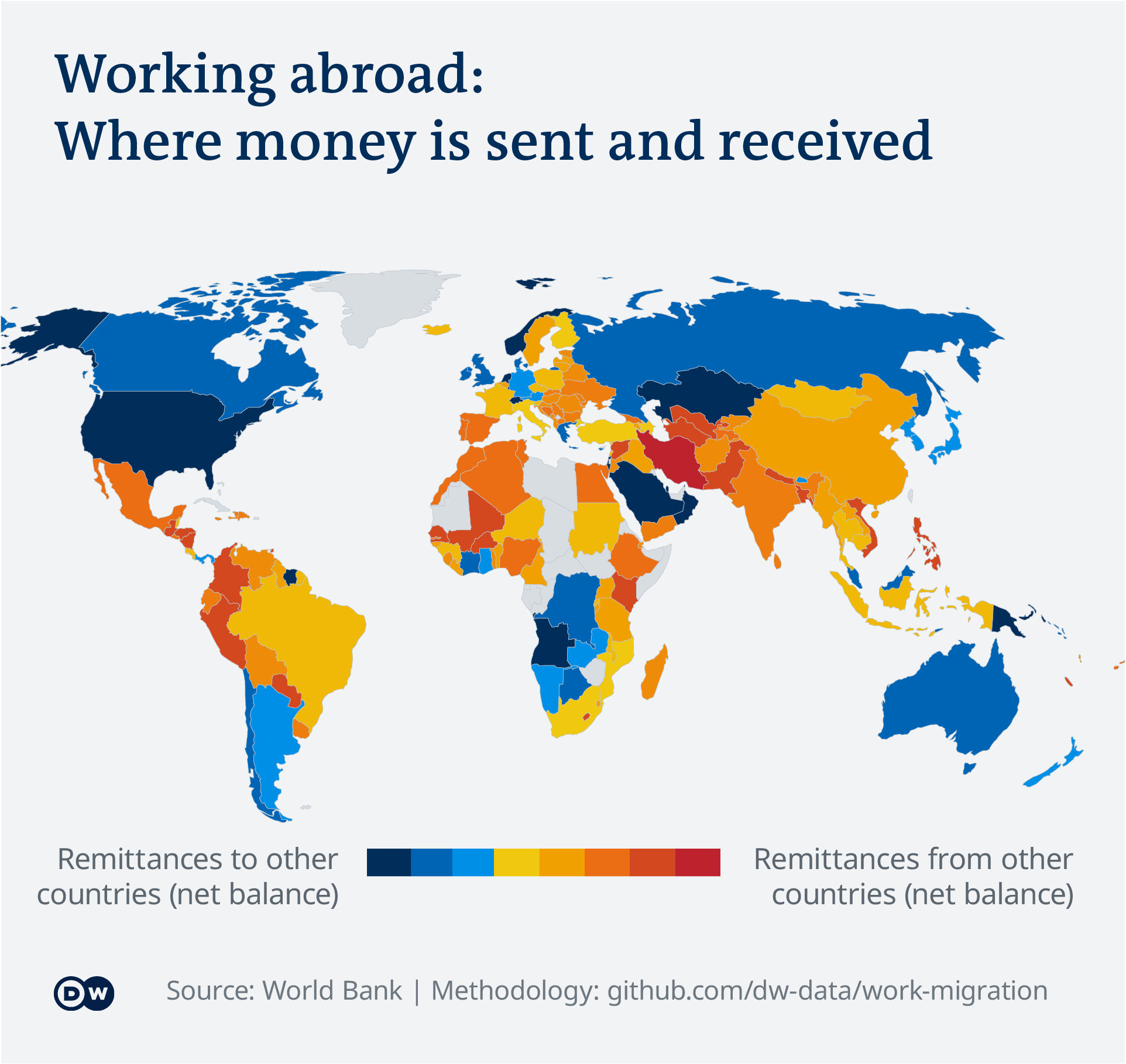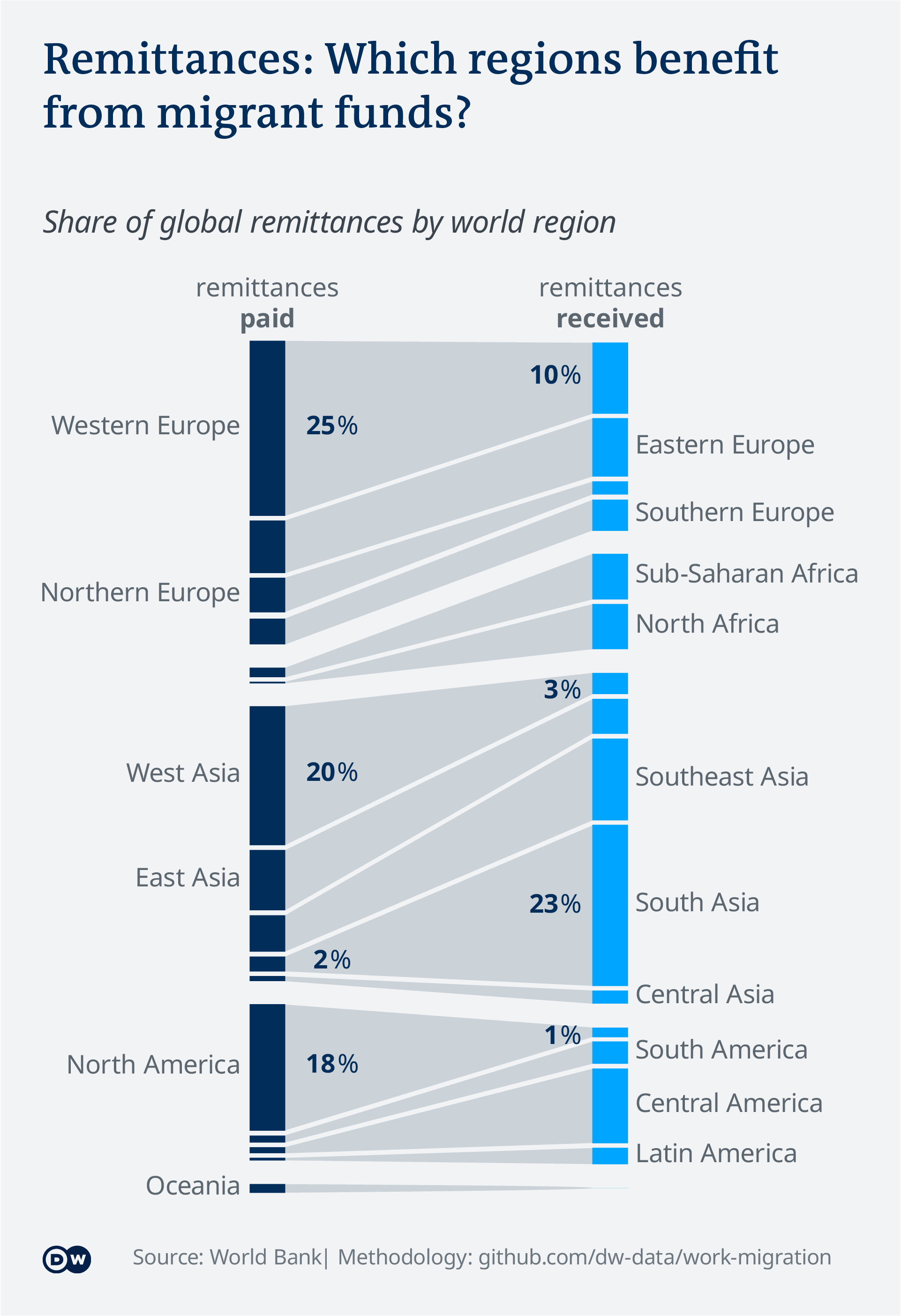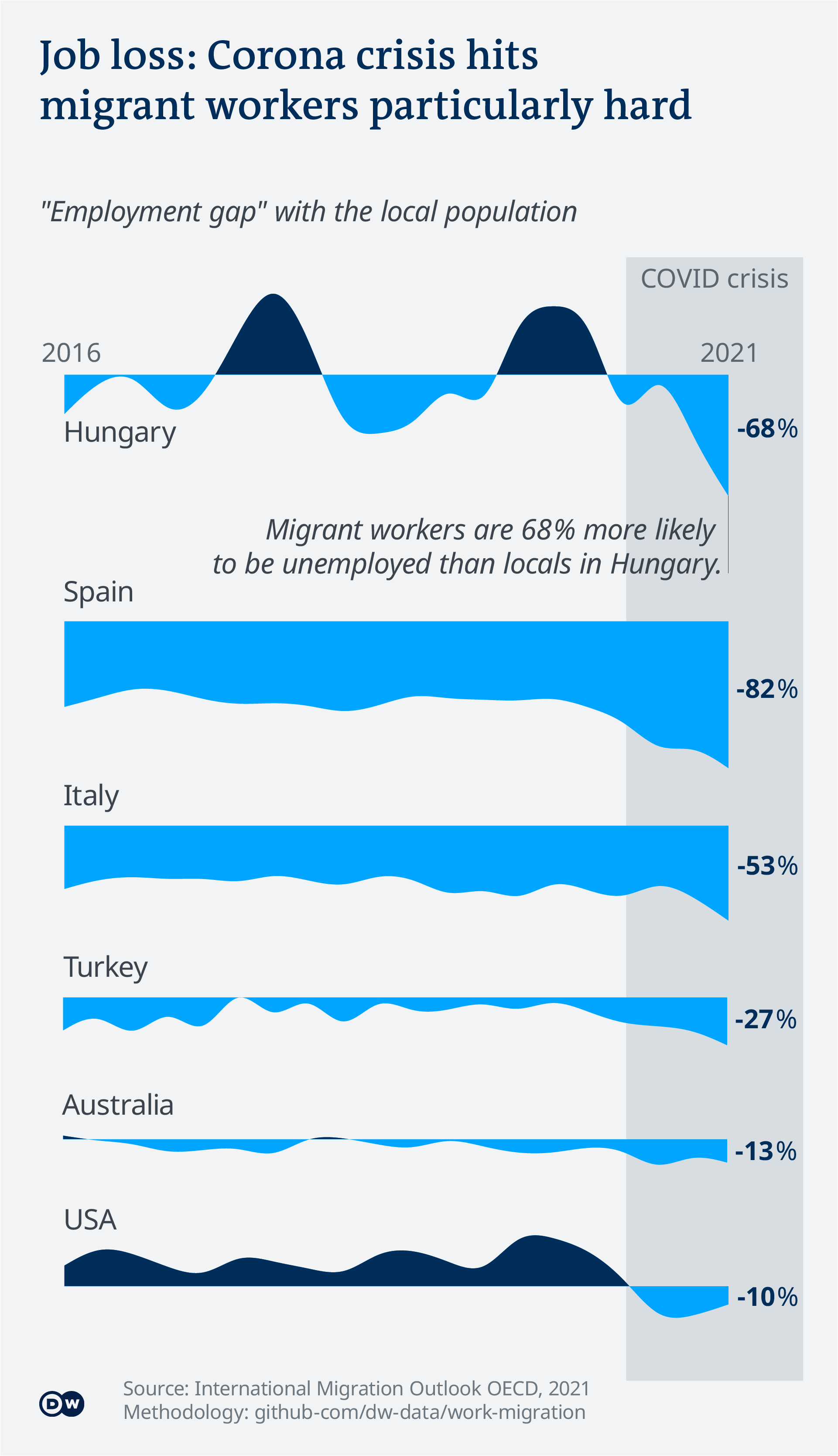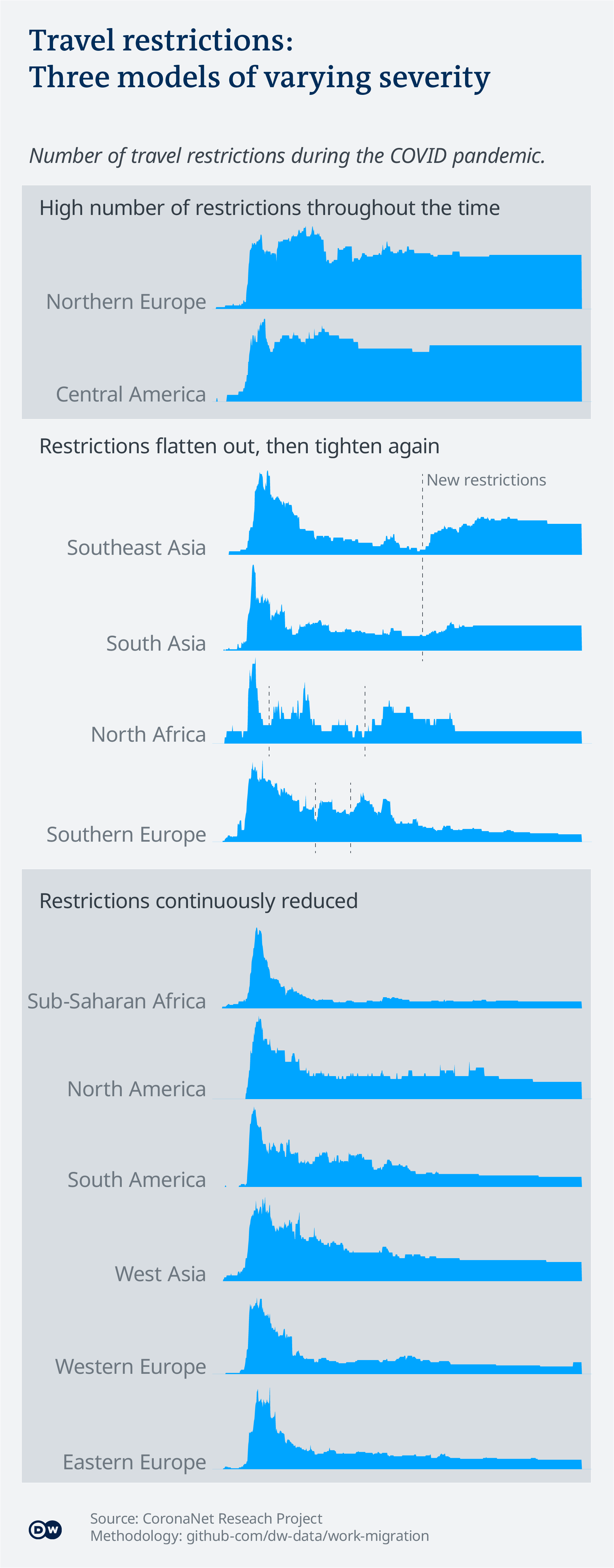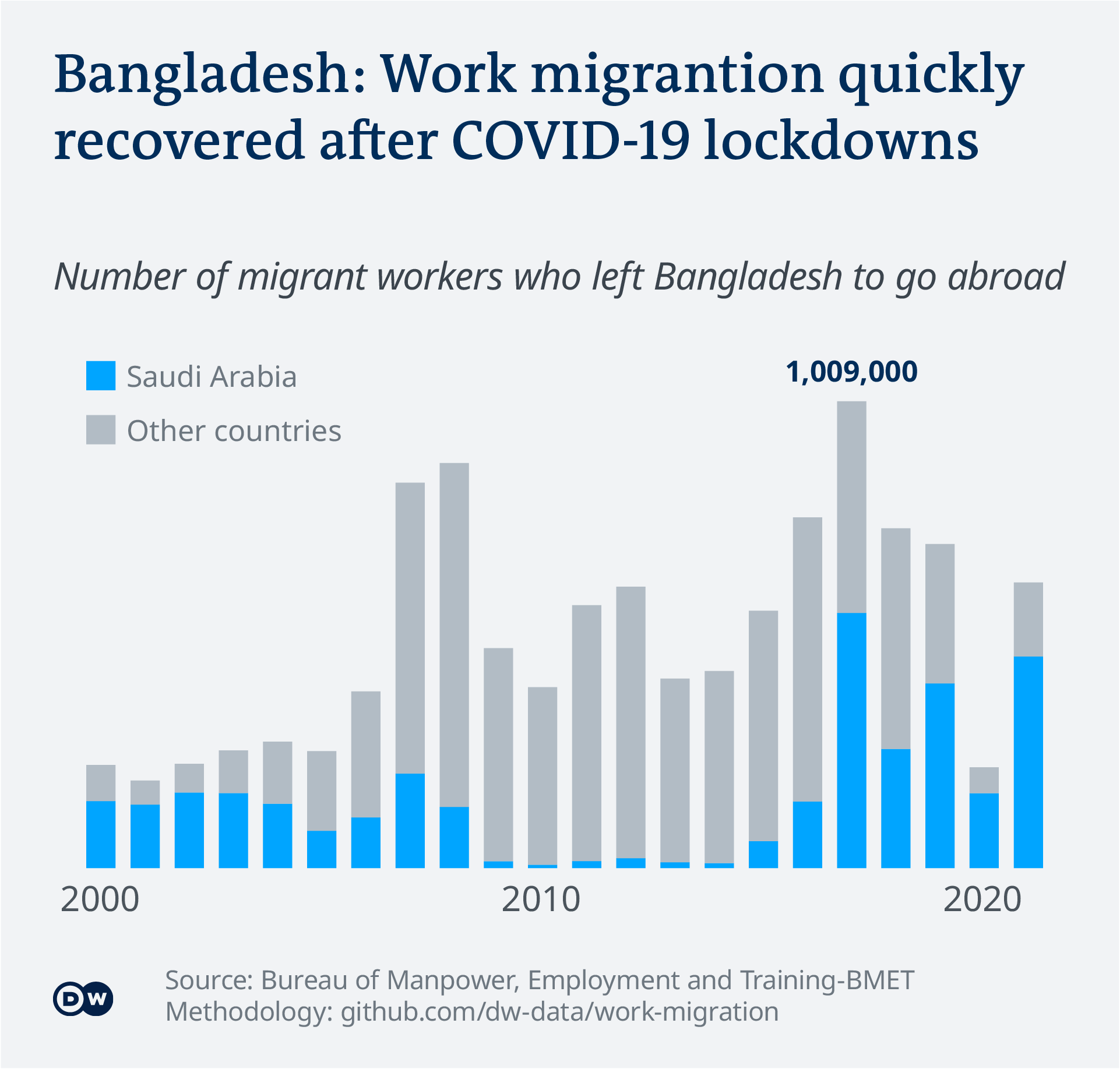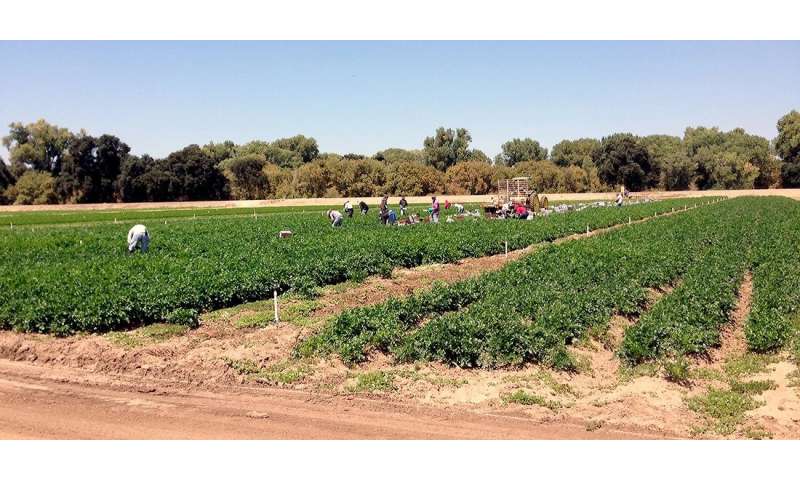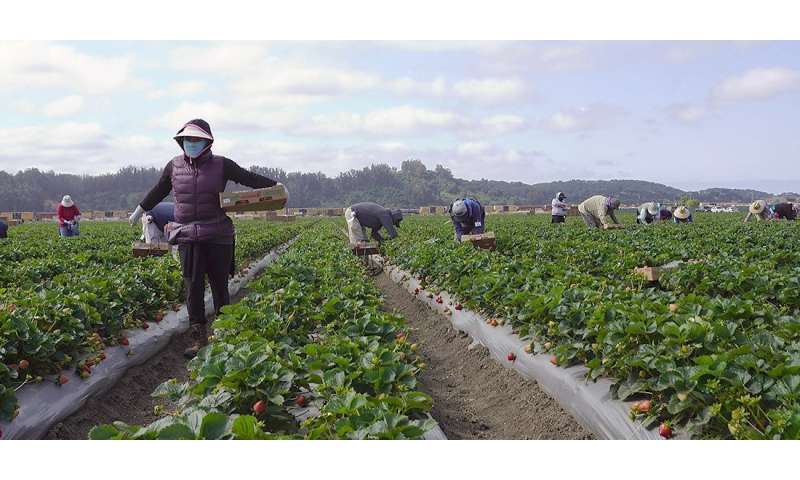Debbie Samaniego
Download PDF
Jul 21 2022 •
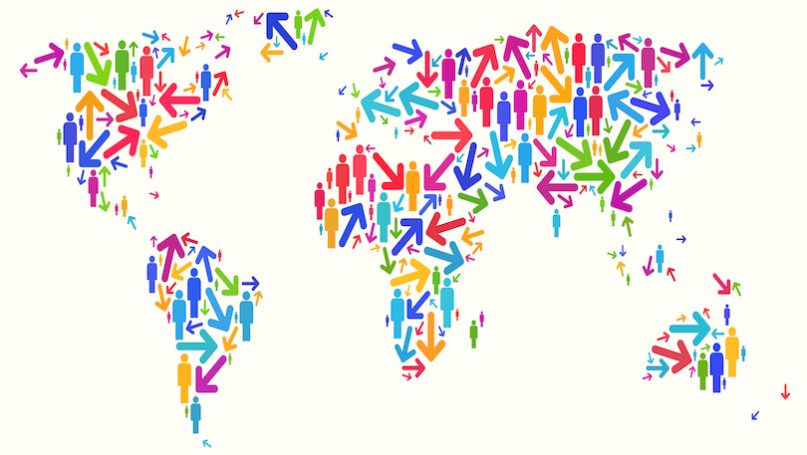
designtools/Shutterstock
Prior to the outbreak of the pandemic, the immigration politics of the US and UK centered on the Trump and Brexit campaigns that called for the removal of migrants and the imperative to ‘take our country back’. Such calls blamed the global movement of racialized migrants as ‘disadvantaging’ certain sectors of the white population and invoked notions of a past when the nation’s “white” population supposedly prospered (Bhambra, 2017). With the outbreak of Covid-19 and the increased pressure on key industries, a simultaneous narrative emerged in both countries that celebrated the bravery and commitments of ‘essential workers’ in the UK and workers who ‘feed America’ in the USA (Samaniego and Mantz, 2020). However, the workers who were celebrated for holding the nation together during the pandemic by working in key industries are precisely those workers who are targeted by the UK and US’s anti-migration, racist, and hyper-nationalist politics. This contradiction, and the broader crisis it is arose in, should not be understood as a moment of exception whereby migrants are accepted within colonial/imperial centers. Rather it is better understood as a continuation of the historical practice of excluding the racialized migrant politically so as to include them (i.e. their labour) informally into an economy in crisis (see Robinson and Santos, 2014; De Genova 2013). As such, we should question the category of essential worker and to what extent it exacerbates the vulnerability of migrant and racialized workers. I argue that the mobilization of this category by the state facilitates historical patterns of disposability and necropolitics in relation to racialized migrant workers.
The category of ‘essential worker’
Immigrants make up a significant share of the workforce in US essential industries (fwd.us, 2020). Immigrants – naturalized US citizens, lawful permanent residents, and undocumented migrants combined – constitute 28% of the workforce in agriculture, 23% in housing and facilities, 19% in food services and production, 19% in transportation, 17% in health, and 15% in other sectors (ibid.). Within this immigrant workforce, undocumented migrants comprise the largest percentage in the agricultural as well as housing and facilities industries (11% and 9% respectively). While these industries were deemed essential during the pandemic, they have in fact always been essential in maintaining social and economic conditions within settler colonial and imperial states. This also means that the labor force within these industries was essential prior to the pandemic and continues to be essential to this day: “In California’s Central Valley—which is responsible for nearly one-quarter of the United States’ food supply, an estimated 70% of farmworkers are unauthorized. In Idaho, unauthorized immigrants total 90% of the state’s dairy industry workforce, demonstrating the essential quality of and national reliance on their labor” (Roberts and Burks, 2021).
The US is no exception. Similar statistics exist for other Global North countries. According to Reid et al. (2021: 74), “[m]igrant workers form the backbone of the agricultural workforce in most developed countries. Germany relies on 300,000 season workers, whereas 90% of Italy’s and 80% of France’s agricultural workers are foreign.” In the EU, “[t]he highest share of migrant workers is among the cleaners and helpers (38%), labourers in mining and constructions (23%), stationary plant and machine operators (20%), and personal care workers (19%)” (Fasani and Mazza, 2020: 1). In the UK, migrants similarly constitute a large share of ‘key workers’ in many industries. The six industries with the highest share of migrant key workers in the UK are manufacturing (35%), information and communication (25%), health (22%), professional and scientific (22%), social work and residential care (19%), and transport and storage (19%) (Migration Observatory, 2022). It is important to recognize that these migrant ‘key’ or ‘essential’ workers had been working within these industries prior to the pandemic. Nevertheless, they were often the target of state anti-migrant policies such as ‘zero-tolerance’ policies in the US (Pierce, Bolter, Selee, 2018) and the ‘hostile environment’ in the UK (Goodfellow, 2019). In the US, industries that are known to rely significantly on migrant workers are often the target of Immigration and Customs Enforcement (ICE) raids. A few months prior to the global outbreak of Covid-19, ICE carried out the largest single-state raid in Mississippi, detaining approximately 680 undocumented migrants working in food processing plants. Less than a year after this raid, these workplaces and workers were deemed essential to the maintenance of the US food supply chain through the Defense Production Act and ordered to continue running despite mass Covid-19 outbreaks.
While there was indeed a growing recognition that migrant workers were essential workers in many Global North states, the term ‘essential worker’ does not function to highlight this reliance on migrant work. Instead, the term allowed for a distancing by the state from this workforce’s immigration status. The deployment of ‘essential worker’ temporarily blurred the contradictions that arose from the state’s reliance on this workforce during the pandemic and the exclusionary, racist, and anti-migrant policies leveled against it. As such, the category of essential worker allowed various states to call upon the labour of racialized migrants whom they had previously sought to remove from their territories or to some extent deemed as not belonging to the ‘nation’. In this context, it is imperative to understand the category of essential worker as a tool the state mobilized during the crisis, rather than a benevolent gesture of state recognition for these workers.
Necropolitics and Disposability Experienced by Migrant Workers
According to Anderson, Poeschel, and Ruhs (2021), “States in the Global North sought to protect, and in some case[s] even expand the supply of such [essential] workers during the health emergency”. However, during the pandemic, migrant workers experienced heightened vulnerabilities to their health and safety. An examination of state exceptions for migrant workers demonstrates that the state did not seek to protect migrant ‘essential workers’ but rather protected ‘essential industries’ that were ordered to continue production. For example, Anderson et al. (2021) finds that:
the Italian government granted temporary legal status to migrants employed irregularly in agriculture and the care sector in spring 2020; the United Kingdom announced the automatic extension of visas of migrant doctors, nurses, and paramedics; Austria and Germany exempted migrants working on farms and in care homes from international travel bans; in the United States, while normal consular operations were suspended, foreign farm workers were still permitted to apply for and receive work visas (OECD, 2020a).
These exemptions granting mobility across borders or temporary legal status were provided by states to stabilize industries that were in crisis rather than providing extra protection to migrant workers in these industries. Instead, these exemptions tied workers to their workplace, which during the pandemic often increased their risk of exposure to the virus. Moreover, a refusal to work in these ‘frontline’ industries could jeopardize their permission to remain in the country. For example, in the US, the pandemic exemptions for essential workers appeared to exacerbate the vulnerability of migrant workers holding H-2A visas:
There was a more than 70% increase in reported likely labor trafficking victims who held H-2A visas that authorizes the work of migrant agricultural workers in the United States. In addition to other abuses, one-third of these individuals complained about being denied medical attention, while they were deemed essential by the United States Government (see Polaris, 2022).
While various states appeared to recognize essential workers for their ‘sacrifice’, these exemptions marked migrant essential workers as disposable (Coleman, 2020; Dias-Abey, 2020) in a necropolitical sense. Mbembe (2004:27) argues that ‘sovereignty means the capacity to define who matters and who does not, who is disposable and who is not.’ The significant number of deaths amongst ‘essential’ BIPOC and BAME workers in the US and UK, both migrant and non-migrant, illustrates the states’ necropolitics. It is an example of state sovereignty mobilized to determine who mattered and who did not. This necropolitical disposability is evident in various accounts from migrant workers in key industries who expressed the lack of safety measures implemented in the workplace such as social distancing and face masks (Coleman, 2020; Dias-Abey, 2020). The label of ‘essential worker’ did not provide additional protections beyond the gesture politics of the state which did not address the vulnerability of migrant or BIPOC and BAME workers.
The concept of ‘essential worker’ emerged out of the state’s identification of key industries (also described as critical infrastructure sectors) and the legal protections that were implemented for them. These legal protections shielded firms from legal liability in relation to Covid-19 (see Carillo and Ipsen, 2021). For instance, in the US, the Defense Production Act (DPA) ordered beef production facilities to continue operating despite the delayed implementation of safety measures which resulted in massive outbreaks in various plants across the US (Hals and Polansek, 2020; Samaniego and Mantz, 2020). The liability protection granted to employers under the DPA made it easy for the meat-industry, which saw massive Covid-19 outbreaks, to deny compensation claims filed in relation to Covid-19 related illnesses, medical expenses, and deaths (Polansek, 2020). In other words, the label of ‘essential worker’ mobilized by the US state and codified by the DPA did not protect workers. It protected industries by ensuring that a workforce which has historically been marked as disposable due to its immigration status bears the frontline dangers of this crisis.
This critique of the state’s deployment of ‘essential worker’ as a political category should caution against the dangers inherent in a politics of recognition (Coulthard, 2014) that does not yield material or structural changes for workers.
Mobility and Colonial Divisions of Labour
The disposability and vulnerability of migrant essential workers is part of a longer continuum of colonial labor practices in settler colonial and imperial states. Various scholars have demonstrated the unequal power relations between (settler-) colonial and imperial states and migrant workers (Gonzalez, 2006; Karuka, 2019; Gutiérrez Rodríguez, 2018). Robinson and Santos (2014: 6-7) argue that:
State controls over immigrant labor and the denial of civil, political, and other citizenship rights to immigrant workers are intended not to prevent but to control the transnational movement of labor and to lock that labor into a situation of permanent insecurity and vulnerability… The creation of these distinct categories (“immigrant labor”) replaces earlier direct colonial and racial caste controls over labor worldwide.
In line with Robinson and Santos’ argument, the category of ‘essential worker’ similarly builds on deeper categories of colonial and racial control of labour. Historically, settler and imperial states have controlled the mobility of colonial subjects by implementing restrictions as well as temporary exemptions to their presence in imperial/settler colonial centers to fulfill labour needs. ‘The Braceros’ in the USA and the ‘Windrush generation’ in the UK are serve as two examples of temporary exemptions granted for the migration of colonial and racialized subjects due to labour shortages. Specifically, both the USA and the UK faced domestic labour shortages during and after the Second World War. They sought to resolve these labour shortages by encouraging migration from Mexico to the USA and the Caribbean to the UK.
The USA established the Bracero Program in 1942, granting nearly 4 million Mexican workers temporary contracts up until the early 1960s (Ngai, 2004). Braceros (the name given to these migrant workers) were recruited to work in labour intensive industries, including farms, railroads, and factories. The Bracero Program helped avert the crisis emerging from labour shortages during the war. As labour shortages subsided after the war, fewer contracts were issued (Mize and Swords, 2010). By 1954, over a decade after the Bracero Program was initiated, the state implemented legislation to ‘repatriate’ undocumented Mexican migrants from the US. Through ‘Operation Wetback’, established in 1954, the state began the mass deportation of approximately 1.3 million Mexican migrants (Mize and Swords, 2010), as well as US citizens of Mexican heritage (Astor, 2009). The Bracero Program demonstrates a cycle of temporary exemptions made for racialized migrant workers when the state experiences a crisis, followed by legislation that facilitates their removal once it is averted. The effects of these racialized labour cycles are still evident today as Latin American workers continue to constitute the largest part of the labor force in the US agricultural sector. In 2018, statistics of hired farm labourers showed that 57% of workers were Hispanic of Mexican origin, while an additional 7% were Hispanic ‘Other’. Put differently, at least 64% of the labor force is Hispanic, not accounting for workers that are undocumented and might not respond to surveys.
In a similar way, the UK encouraged the migration of ‘Citizens of the United Kingdom and Colonies’ to address labour shortages exacerbated by the Second World War. According to Shilliam (2018:85-86), ‘[i]n 1946 the Labour government set up a foreign labour committee to examine shortages in the industries essential to postwar reconstruction: coal, textiles, steel, construction and agriculture. With the lack of workforce estimated at almost one million, the government turned, necessarily, towards the importation of labour power’. Goodfellow (2019:43) explains that ‘[t]he Second World War had left the UK in economic decline’, thus ‘Post-war reconstruction required workers, and the official line was that the country at the centre of the Commonwealth would take anyone willing and able to work, regardless of colour’. Approximately half a million people arrived in the UK between 1947 and 1970 from the West Indies (National Archives, 2022). Similar to Braceros, these British citizens migrating from British colonies were legally allowed to work in the UK to avert the labour crisis experienced by the imperial state. However, by the 1960s, there were growing concerns over the increased presence of non-white Commonwealth citizens in the UK and the ‘government wanted to make it more difficult for people of colour to come to the country’ (Goodfellow, 2019: 47). As a result, the 1962 Commonwealth Immigrants Act placed restrictions on their mobility by requiring Commonwealth citizens to acquire ‘an employment voucher from the British government to come and live in the country’ (ibid.). In this way, the 1962 Commonwealth Immigrants Act alongside subsequent immigration acts, continued to erode the right to mobility of Commonwealth citizens within the imperial centre. This right was now tied to some extent to the labour needs of the British government.
Conclusion
It is important to place temporary exemptions that tie migrant ‘essential workers’ to their workplace during the pandemic within the context of such histories of colonial labor relations. It is crucial to understand the disposability and vulnerability of ‘essential workers’ in relation historical processes that order mobility and labor across the world. As others have remarked, ‘the association of some kinds of dangerous, low-status, fast-paced, insecure work with racialized people or with foreign nationals is a feature of racial capitalism’ (Rogaly and Schling, 2021: 382). The historically constructed racialized division of labor created and upheld by settler colonial and imperial states continues to produce violence and injustices against current and former subjects of Empire. Many Global North states rely on an immigration system that allows for the exploitation and disposability of migrant workers in specific labour intensive and dangerous industries. For instance, visa programs such as the H-2A visa in the USA tie migrants to their employer, making them precarious and exploitable. These visa programs are not too dissimilar to the Bracero Program’s temporary work contracts or the work voucher scheme the UK government implemented in the 1960s. The exemptions made for the presence of migrants in various Global North states during the pandemic operate squarely within a global colonial order, one that relies on immigration and border controls to enforce a necropolitical and racialized division of labour.
By connecting colonial processes and histories to contemporary politics, it becomes clear that addressing these issues requires more than reform to the immigration system. Instead, it requires the abolition of borders, border regimes, and the colonial labour systems they sustain. We must refuse a politics of recognition and gesture politics, and instead contribute to radical internationalists, pro-migrant and anti-racist labour movement.
References
Anderson, B., Poeschel, F., & Ruhs, M. (2021) “Rethinking labour migration: Covid-19, essential work, and systemic resilience”, Comparative Migration Studies, 9(1), 1-19.
Bradley, G. M., & de Noronha, L. (2022). Against Borders: The Case for Abolition. Verso Books.
Carrillo, I. R., & Ipsen, A. (2021) “Worksites as Sacrifice Zones: Structural precarity and Covid-19 in US meatpacking”, Sociological Perspectives, 64(5), 726-746.
Dias-Abey, Manoj (2020) “Disposable workers, essential work: migrant farmworkers during the COVID pandemic”, Migration Mobilities Bristol, available online at: https://migration.bristol.ac.uk/2020/08/11/disposable-workers-essential-work-migrant-farmworkers-during-the-covid-pandemic/ (accessed 19 June 2022).
Gonzalez, G. G. (2015) Guest workers or colonized labor?: Mexican labor migration to the United States. (London: Routledge).
Goodfellow, M. (2019). Hostile environment: How immigrants became scapegoats. Verso Books.
Gutiérrez Rodríguez, E. (2018). The coloniality of migration and the “refugee crisis”: On the asylum-migration nexus, the transatlantic white European settler colonialism-migration and racial capitalism. Refuge: Canada’s Journal on Refugees/Refuge: revue canadienne sur les réfugiés, 34(1), 16-28.
Pierce, S., Bolter, J., & Selee, A. (2018) “US immigration policy under Trump: Deep changes and lasting impacts”, Migration Policy Institute, 9, 1-24.
Reid, Alison, Elena Rhonda-Perez, and Marc B. Schenker (2021) “Migrant Workers, Essential Work, and COVID-19”, American Journal of Industrial Medicine, 64(2): 73–77.
Robinson, W., & Santos, X. (2014). Global capitalism, immigrant labor, and the struggle for justice. Class, Race and Corporate Power, 2(3), 1-16.
Rogaly, B. (2021) “Commentary: Agricultural racial capitalism and rural migrant workers”, Journal of Rural Studies, 88, 527-531.
Rogaly, B., & Schling, H. (2021) “Labour geography, racial capitalism, and the pandemic portal”, in Andrews, G. J., Crooks, V. A., Pearce, J., & Messina, J. P. (eds.) COVID-19 and similar futures: Pandemic Geographies (Springer, Cham), pp. 381-385.
Shilliam, R. (2018) Race and the undeserving poor: From abolition to Brexit. Agenda Publishing.
Subcomandante Marcos (2001) Our Word is Our Weapon – Selected Writings (London: Seven Stories Press).
Further Reading on E-International Relations
Labouring Geography: Towards World-Making Praxis in a Global Pandemic
Covid in an Uneven World: Are We All in This Together
Opinion — Paradiplomacy in Times of Pandemic: The Paths Ahead
Oil Power Politics amidst a Global Pandemic
Opinion – The Fragile Power of Populist Leaders in a Pandemic
ABOUT THE AUTHOR(S)
Debbie Samaniego is a Doctoral Tutor in the Department of International Relations at the University of Sussex. She holds a PhD in International Relations from the University of Sussex. Her research focuses on the intersection of decolonial theory, colonial histories, processes of racialization, migration, and the modern international order.

